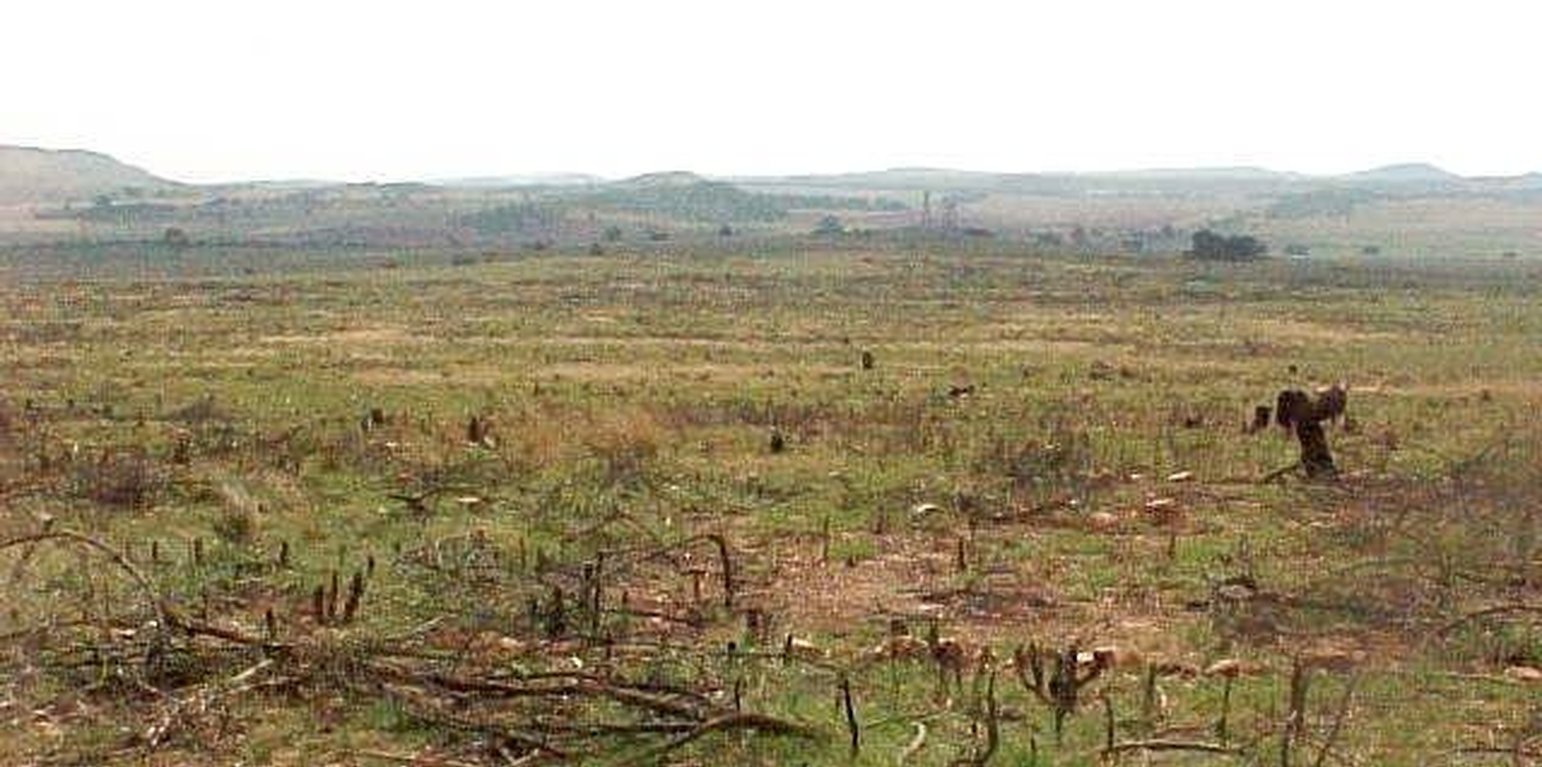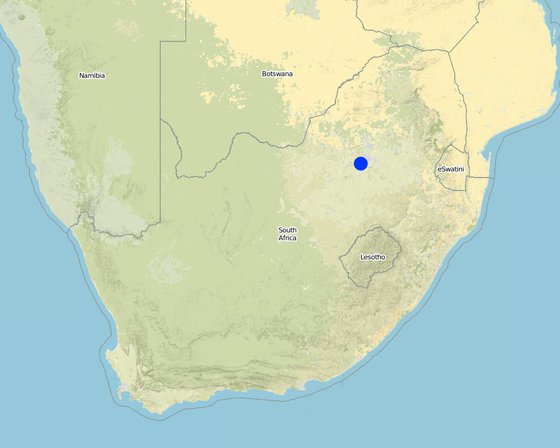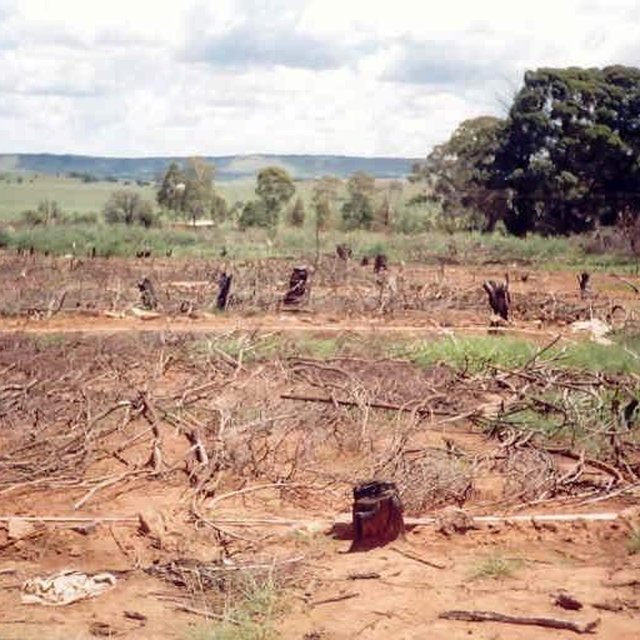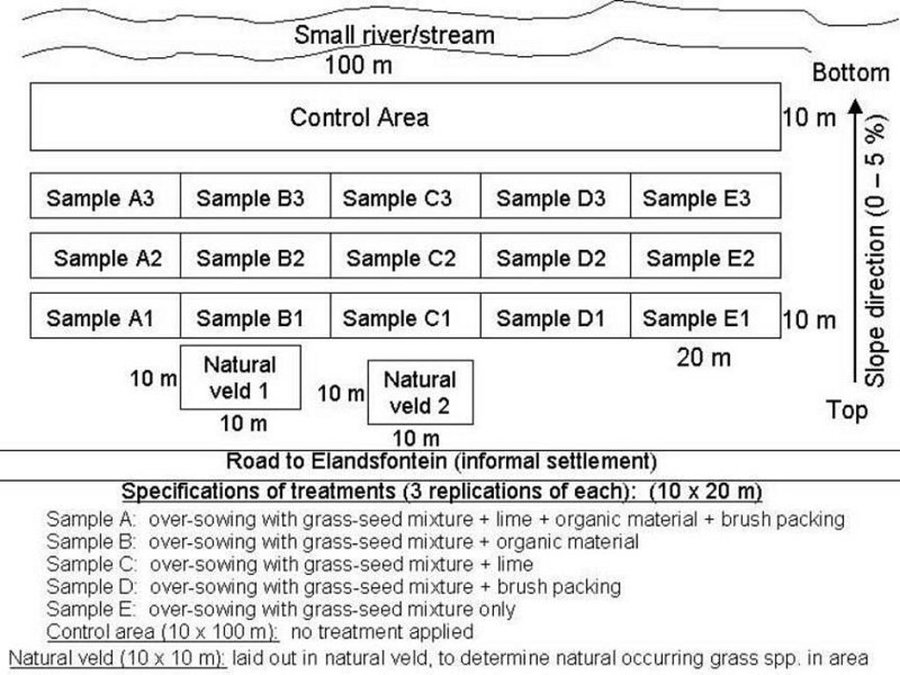



A research investigation was undertaken in an area of degraded communal rangeland, which had been invaded by an alien tree species (Acacia mearnsii – black wattle). Competition from the water-demanding A. mearnsii, combined with overgrazing, had resulted in an almost total absence of palatable grasses. All that was left were a few patches of star grass (or ‘bermuda grass’: Cynodon dactylon). Prior to the research, discussions were held between personnel of the ‘Working for Water’ programme of the South African government and community members.
The purpose of the trials was to determine how best to eradicate the invasive trees and revegetate the rangeland. The restoration area was not fenced off and was thus open to grazing. The trials comprised five treatments, with three replicates each, on plots of 10 m by 20 m. In all treatments the A. mearnsii was eradicated manually, and chemical biocide applied to the stumps to prevent regrowth. Lime and grass seed (of palatable species) were applied to the loosened surface and covered with soil. The five treatments were:
(A) oversowing with grass seed mixture, supplementing of dolomitic lime, cattle dung, and ‘brush packing’ (see below for explanation of term);
(B) oversowing with grass seed mixture and supplementing with cattle dung;
(C) oversowing with grass seed mixture and supplementing with dolomitic lime;
(D) oversowing with grass seed mixture and brush packing;
(E) oversowing with grass seed mixture only.
In addition stone lines were laid out along the contour, between plots. The ‘brush packing’, referred to in treatments A and D comprised branches laid out in strips across the slope to retard runoff, trap soil, improve the micro-climate for establishing grass seedlings and protect the young plants from browsing by animals. The results showed treatment A to be the most effective in restoring the productive and protective function of the rangeland. From the trials, the estimated costs of applying the best technology would be US$ 230 per hectare. The key constraints for successful adoption however are not just technical, but include: (1) the need to protect the area from grazing and trampling by animals during the establishment period; (2) stopping removal of brushwood for firewood; and (3) the need for community agreement on initial protection and subsequent sustainable utilisation of the restored range.
Establishment activities:
1.Manual eradication of trees with chain saw and axe
2.Application of chemical biocide to the stumps to prevent any regrowth
3.Ripping of soil surface to a depth of 5 cm using a three tined hand implement
4.Application of dolomitic lime and raking it into soil after ripping of the soil
5.Application of organic material (cattle dung) after ripping and lime application
6.Oversowing with grass seed mixture after ripping of the soil and application of lime and organic material
7.Brush packing against contour and packing of rock contours against the slope All the branches and stones were collected from the restoration area. Rock contours were packed against (perpendicular) to the slope in the study area at varying intervals (approximately 10-15 m apart) in order to retard runoff water, trap soil, and improve conditions for seed germination (see inserted drawing below and attachment). Branches were packed (brush packing) along the slope in certain treatments within the study site in order to trap soil, retard runoff water en serve as a micro-climate for germinating and establishing grass seedlings
Total duration of restoration took 3 years, from removal of trees till revegetation trials were laid out and technology was established.
Maintenance / recurrent activities per year:
Following initial establishment maintenance was limited to 2 follow up applications of herbicide (after 3 and 5 months). Maintenance of contours was not done after restoration.

Location: Johannesburg, Gauteng, South Africa
No. of Technology sites analysed:
Spread of the Technology: evenly spread over an area (9.0 km²)
In a permanently protected area?:
Date of implementation: less than 10 years ago (recently)
Type of introduction










| Specify input | Unit | Quantity | Costs per Unit (Rand) | Total costs per input (Rand) | % of costs borne by land users |
| Labour | |||||
| labour | ha | 1.0 | 35.0 | 35.0 | |
| Equipment | |||||
| machine use | ha | 1.0 | 65.0 | 65.0 | |
| tools | ha | 1.0 | 5.0 | 5.0 | |
| Plant material | |||||
| seeds | ha | 1.0 | 70.0 | 70.0 | |
| Fertilizers and biocides | |||||
| fertilizer | ha | 1.0 | 25.0 | 25.0 | |
| biocides | ha | 1.0 | 30.0 | 30.0 | |
| Total costs for establishment of the Technology | 230.0 | ||||
| Total costs for establishment of the Technology in USD | 28.05 | ||||
| Specify input | Unit | Quantity | Costs per Unit (Rand) | Total costs per input (Rand) | % of costs borne by land users |
| Labour | |||||
| labour | ha | 1.0 | 7.0 | 7.0 | |
| Equipment | |||||
| tools | ha | 1.0 | 5.0 | 5.0 | |
| Fertilizers and biocides | |||||
| biocides | ha | 1.0 | 20.0 | 20.0 | |
| Total costs for maintenance of the Technology | 32.0 | ||||
| Total costs for maintenance of the Technology in USD | 3.9 | ||||
Brush packing was removed by community members for firewood.
Not all labourers could be employed, more would have like to have the job (money).
Capacity building awareness
Farmers not positive about SWC project and effect.
Quantity before SLM: 2
Quantity after SLM: 1